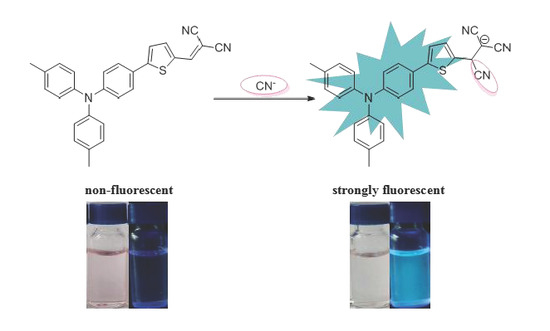A Biocompatible Colorimetric Triphenylamine- Dicyanovinyl Conjugated Fluorescent Probe for Selective and Sensitive Detection of Cyanide Ion in Aqueous Media and Living Cells
Abstract
:1. Introduction
2. Results and Discussion
2.1. Synthesis of Probe 1
2.2. Selectivity over Other Anions
2.3. Colorimetric and Fluorescent Detection
2.4. Spectral Titration of Probe 1
2.5. The Sensing Mechanism
2.6. Cellular Imaging
3. Experimental Section
3.1. Materials and Instruments
3.2. Synthesis of Probe 1
3.2.1. Synthesis of 4-bromo-N,N-di-p-tolylaniline (3)
3.2.2. Synthesis of 5-(4-(di-p-tolylamino)phenyl)thiophene-2-carbaldehyde (4)
3.2.3 Synthesis of 2-((5-(4-(di-p-tolylamino)phenyl)thiophen-2-yl)methylene)malononitrile (1)
3.3. General Fluorescence Spectra Measurements
3.4. Cell Culture and Confocal Fluorescence Imaging
4. Conclusions
Supplementary Materials
Acknowledgments
Author Contributions
Conflicts of Interest
References
- Busschaert, N.; Caltagirone, C.; Rossom, W.V.; Gale, P.A. Applications of supramolecular anion recognition. Chem. Rev. 2015, 115, 8038–8155. [Google Scholar] [CrossRef] [PubMed]
- Wang, F.; Wang, L.; Chen, X.; Yoon, J. Recent progress in the development of fluorometric and colorimetric chemosensors for detection of cyanide ions. Chem. Soc. Rev. 2014, 43, 4312–4324. [Google Scholar] [CrossRef] [PubMed]
- Merwe, S.W.; Schoeller, F.; Bolzer, W.; Germonper, R.; Heller, L.; Filho, E.H.; Formaggia, D.M.E.; Blum, J.C.; Omori, M.J.; Mancuso, P.C.S. Guidelines for Drinking-Water Quality; World Health Organization: Geneva, Switzerland, 1996. [Google Scholar]
- Kulig, K.W. Cyanide Toxicity; U.S. Department of Health and Human Services: Atlanta, GA, USA, 1991.
- Anzenbacher, P.J.; Tyson, D.S.; Jursikova, K.; Castellano, F.N. Luminescence lifetime-based sensor for cyanide and related anions. J. Am. Chem. Soc. 2002, 124, 6232–6233. [Google Scholar] [CrossRef] [PubMed]
- Ishii, A.; Seno, H.; Watanabe-Suzuki, K.; Suzuki, O. Determination of cyanide in whole blood by capillary gas chromatography with cryogenic oven trapping. Anal. Chem. 1998, 70, 4873–4876. [Google Scholar] [CrossRef] [PubMed]
- Timofeyenko, Y.G.; Rosentreter, J.J.; Mayo, S. Piezoelectric quartz crystal microbalance sensor for trace aqueous cyanide ion determination. Anal. Chem. 2007, 79, 251–255. [Google Scholar] [CrossRef] [PubMed]
- Ding, G.; Zhou, H.; Xu, J.; Lu, X. Electrofluorochromic detection of cyanide anions using a benzothiadiazole-containing conjugated copolymer. Chem. Commun. 2014, 50, 655–657. [Google Scholar] [CrossRef] [PubMed]
- Suzuki, T.; Hiolki, A.; Kurahashi, M. Development of a method for estimating an accurate equivalence point in nickel titration of cyanide ions. Anal. Chim. Acta 2003, 476, 159–165. [Google Scholar] [CrossRef]
- Cacace, D.; Ashbaugh, H.; Kouri, N.; Bledsoe, S.; Lancaster, S.; Chalk, S. Spectrophotometric determination of aqueous cyanide using a revised phenolphthalin method. Anal. Chim. Acta 2007, 589, 137–141. [Google Scholar] [CrossRef] [PubMed]
- Maldonado, C.R.; Touceda-Varela, A.; Jonesa, A.C.; Mareque-Rivas, J.C. A turn-on fluorescence sensor for cyanide from mechanochemical reactions between quantum dots and copper complexes. Chem. Commun. 2011, 47, 11700–11702. [Google Scholar] [CrossRef] [PubMed]
- Lee, K.S.; Kim, H.J.; Shin, I.; Hong, J.I. Fluorescent chemodosimeter for selective detection of cyanide in water. Org. Lett. 2008, 10, 49–51. [Google Scholar] [CrossRef] [PubMed]
- Badugu, R.; Lakowicz, J.R.; Geddes, C.D. Fluorescence intensity and lifetime-based cyanide sensitive probes for physiological safeguard. Anal. Chim. Acta 2004, 522, 9–17. [Google Scholar] [CrossRef]
- Badugu, R.; Lakowicz, J.R.; Geddes, C.D. Enhanced fluorescence cyanide detection at physiologically lethal levels: Reduced ICT-based signal transduction. J. Am. Chem. Soc. 2005, 127, 3635–3641. [Google Scholar] [CrossRef] [PubMed]
- Jung, H.S.; Han, J.H.; Kim, Z.H.; Kang, C.; Kim, J.S. Coumarin-Cu(II) ensemble-based cyanide sensing chemodosimeter. Org. Lett. 2011, 13, 5056–5059. [Google Scholar] [CrossRef] [PubMed]
- Lee, H.; Kim, H.J. Highly selective sensing of cyanide by a benzochromene-based ratiometric fluorescence probe. Tetrahedron Lett. 2012, 53, 5455–5457. [Google Scholar] [CrossRef]
- Park, S.; Kim, H.J. Highly activated Michael acceptor by an intramolecular hydrogen bond as a fluorescence turn-on probe for cyanide. Chem. Commun. 2010, 46, 9197–9199. [Google Scholar] [CrossRef] [PubMed]
- Xu, Z.; Chen, X.; Kim, H.N.; Yoon, J. Sensors for the optical detection of cyanide ion. Chem. Soc. Rev. 2010, 39, 127–137. [Google Scholar] [CrossRef] [PubMed]
- Kang, N.Y.; Ha, H.H.; Yun, S.W.; Yu, Y.H.; Chang, Y.T. Diversity-driven chemical probe development for biomolecules: Beyond hypothesis-driven approach. Chem. Soc. Rev. 2011, 40, 3613–3626. [Google Scholar] [CrossRef] [PubMed]
- Zou, Q.; Zou, L.; Tian, H. Detection and adsorption of Hg2+ by new mesoporous silica and membrane material grafted with a chemodosimeter. J. Mater. Chem. 2011, 21, 14441–14447. [Google Scholar] [CrossRef]
- Zou, Q.; Tian, H. Chemodosimeters for mercury(II) and methylmercury(I) based on 2,1,3-benzothiadiazole. Sens. Actuators B 2010, 149, 20–27. [Google Scholar] [CrossRef]
- Ren, J.Q.; Zhu, W.H.; Tian, H. A highly sensitive and selective chemosensor for cyanide. Talanta 2008, 75, 760–764. [Google Scholar] [CrossRef] [PubMed]
- Gong, W.T.; Zhang, Q.L.; Shang, L.; Gao, B.; Ning, G.L. A new principle for selective sensing cyanide anions based on 2-hydroxy-naphthaldeazine compound. Sens. Actuators B 2013, 177, 322–326. [Google Scholar] [CrossRef]
- Jo, J.; Lee, D. Turn-on fluorescence detection of cyanide in water: Activation of latent fluorophores through remote hydrogen bonds that mimic peptide β-turn motif. J. Am. Chem. Soc. 2009, 131, 16283–16291. [Google Scholar] [CrossRef] [PubMed]
- Gimeno, N.; Li, X.; Durrant, J.R.; Vilar, R. Cyanide sensing with organic dyes: Studies in solution and on nanostructured Al2O3 surfaces. Chem. Eur. J. 2008, 14, 3006–3012. [Google Scholar] [CrossRef] [PubMed]
- Chen, X.; Nam, S.; Kim, G.; Song, N.; Jeong, Y.; Shin, I.; Kim, S.K.; Kim, J.; Park, S.; Yoon, J. Cyanide sensing with organic dyes: Studies in solution and on nanostructured Al2O3 surfaces. Chem. Commun. 2010, 46, 8953–8955. [Google Scholar] [CrossRef] [PubMed]
- Dai, Z.; Boon, E.M. Engineering of the heme pocket of an H-NOX domain for direct cyanide detection and quantification. J. Am. Chem. Soc. 2010, 132, 11496–11503. [Google Scholar] [CrossRef] [PubMed]
- Lee, J.H.; Jeong, A.R.; Shin, I.S.; Kim, H.J.; Hong, J.I. Fluorescence turn-on sensor for cyanide based on a cobalt(II)-coumarinylsalen complex. Org. Lett. 2010, 12, 764–767. [Google Scholar] [CrossRef] [PubMed]
- Liu, Y.L.; Lv, X.; Zhao, Y.; Liu, J.; Sun, Y.Q.; Wang, P.; Guo, W. A Cu(II)-based chemosensing ensemble bearing rhodamine B fluorophore for fluorescence turn-on detection of cyanide. J. Mater. Chem. 2012, 22, 1747–1750. [Google Scholar] [CrossRef]
- Ajayakumar, M.R.; Mukhopadhyay, P. Single-electron transfer driven cyanide sensing: A new multimodal approach. Org. Lett. 2010, 12, 2646–2649. [Google Scholar] [CrossRef] [PubMed]
- Ajayakumar, M.R.; Asthana, D.; Mukhopadhyay, P. Core-modified naphthalenediimides generate persistent radical anion and cation: New panchromatic NIR probes. Org. Lett. 2012, 14, 4822–4825. [Google Scholar] [CrossRef] [PubMed]
- Ajayakumar, M.R.; Mandal, K.; Rawat, K.; Asthana, D.; Pandey, R.; Sharma, A.; Yadav, S.; Ghosh, S.; Mukhopadhyay, P. Single electron transfer-driven multi-dimensional signal read-out function of TCNQ as an “Off-the-Shelf” detector for cyanide. ACS Appl. Mater. Interfaces 2013, 5, 6996–7000. [Google Scholar] [CrossRef] [PubMed]
- Huo, F.J.; Su, J.; Sun, Y.Q.; Yin, C.X.; Chao, J.B. A new ring-opening chromene molecule: Colorimetric detection of cyanide anion. Chem. Lett. 2010, 39, 738–740. [Google Scholar] [CrossRef]
- Peng, M.J.; Guo, Y.; Yang, X.F.; Wang, L.Y.; An, J. A highly selective ratiometric and colorimetric chemosensor for cyanide detection. Dyes Pigment. 2013, 98, 327–332. [Google Scholar] [CrossRef]
- Shan, Y.; Liu, Z.; Cao, D.; Sun, Y.; Wang, K.; Chen, H. Nitro substituted chalcone derivatives as quick-response chemosensors for cyanide anions. Sens. Actuators B Chem. 2014, 198, 15–19. [Google Scholar] [CrossRef]
- Sun, X.; Wang, Y.; Deng, X.; Zhang, J.; Zhang, Z. A colorimetric and ratiometric fluorescent probe for the selective detection of cyanide anions in aqueous media and living cells. RSC. Adv. 2016, 6, 10266–10271. [Google Scholar] [CrossRef]
- Lv, X.; Liu, J.; Liu, Y.L.; Zhao, Y.; Chen, M.L.; Wang, P.; Guo, W. Rhodafluor-based chromo-and fluorogenic probe for cyanide anion. Sens. Actuators B Chem. 2011, 158, 405–410. [Google Scholar] [CrossRef]
- Jeong, Y.H.; Lee, C.H.; Jang, W.D. A Diketopyrrolopyrrole-Based Colorimetric and Fluorescent Probe for Cyanide Detection. Chem. Asian J. 2012, 7, 1562–1566. [Google Scholar] [CrossRef] [PubMed]
- Yuan, L.; Lin, W.Y.; Yang, Y.T.; Song, J.Z.; Wang, J.L. Rational design of a highly reactive ratiometric fluorescent probe for cyanide. Org. Lett. 2011, 13, 3730–3733. [Google Scholar] [CrossRef] [PubMed]
- Kim, H.J.; Ko, K.C.; Lee, J.H.; Lee, J.Y.; Kim, J.S. KCN sensor: Unique chromogenic and “turn-on” fluorescent chemodosimeter: Rapid response and high selectivity. Chem. Commun. 2011, 47, 2886–2888. [Google Scholar] [CrossRef] [PubMed]
- Li, Y.; Ren, T.; Dong, W.J. Tuning photophysical properties of triphenylamine and aromatic cyano conjugate-based wavelength-shifting compounds by manipulating intramolecular charge transfer strength. J. Photochem. Photobiol. A Chem. 2013, 251, 1–9. [Google Scholar] [CrossRef]
- Cheng, X.; Zhou, Y.; Qin, J.; Li, Z. Reaction-based colorimetric cyanide chemosensors: Rapid naked-eye detection and high selectivity. ACS Appl. Mater. Interfaces 2012, 4, 2133–2138. [Google Scholar] [CrossRef] [PubMed]
- Lee, C.H.; Yoon, H.J.; Shim, J.S.; Jang, W.D. A Boradiazaindacene-based turn-on fluorescent probe for cyanide detection in aqueous media. Chem. Eur. J. 2012, 18, 4513–4516. [Google Scholar] [CrossRef] [PubMed]
- Yang, L.; Li, X.; Yang, J.; Qu, Y.; Hua, J. Colorimetric and ratiometric near-infrared fluorescent cyanide chemodosimeter based on phenazine derivatives. ACS Appl. Mater. Interfaces 2013, 5, 1317–1326. [Google Scholar] [CrossRef] [PubMed]
- Zhang, Q.; Zhang, J.; Zuo, H.; Wang, C.; Shen, Y. A novel colorimetric and fluorescent sensor for cyanide anions detection based on triphenylamine and benzothiadiazole. Tetrahedron 2016, 72, 1244–1248. [Google Scholar] [CrossRef]
- Qu, Y.; Jin, B.; Liu, Y.; Wu, Y.; Yang, L.; Wu, J.; Hua, J. A new triphenylamine fluorescent dye for sensing of cyanide anion in living cell. Tetrahedron Lett. 2013, 54, 4942–4944. [Google Scholar] [CrossRef]
- Zou, Q.; Li, X.; Xu, Q.; Ågren, H.; Zhao, W.; Qu, Y. A near-infrared “on-off” fluorescent and colourimetric cyanide chemodosimeter based on phenothiazine with applications in living cell imaging. RSC Adv. 2014, 4, 59809–59816. [Google Scholar] [CrossRef]
- Wang, S.; Xu, H.; Yang, Q.; Song, Y.; Li, Y. A triphenylamine-based colorimetric and “turn-on” fluorescent probe for detection of cyanide anions in live cells. RSC Adv. 2015, 5, 47990–47996. [Google Scholar] [CrossRef]
- Yang, Y.; Yin, C.; Huo, F.; Chao, J.; Zhang, Y.; Cheng, F. A new highly selective and turn-on fluorescence probe for detection of cyanide. Sens. Actuators B Chem. 2014, 193, 220–224. [Google Scholar] [CrossRef]
- Sun, Y.; Fan, S.; Duan, L.; Li, R. A ratiometric fluorescent probe based on benzo [e] indolium for cyanide ion in water. Sens. Actuators B Chem. 2013, 185, 638–643. [Google Scholar] [CrossRef]
- Pati, P.B.; Zade, S.S. Dicyanovinyl terthiophene as a reaction based colorimetric and ratiometric fluorescence probe for cyanide anions. RSC Adv. 2013, 3, 13457–13462. [Google Scholar] [CrossRef]
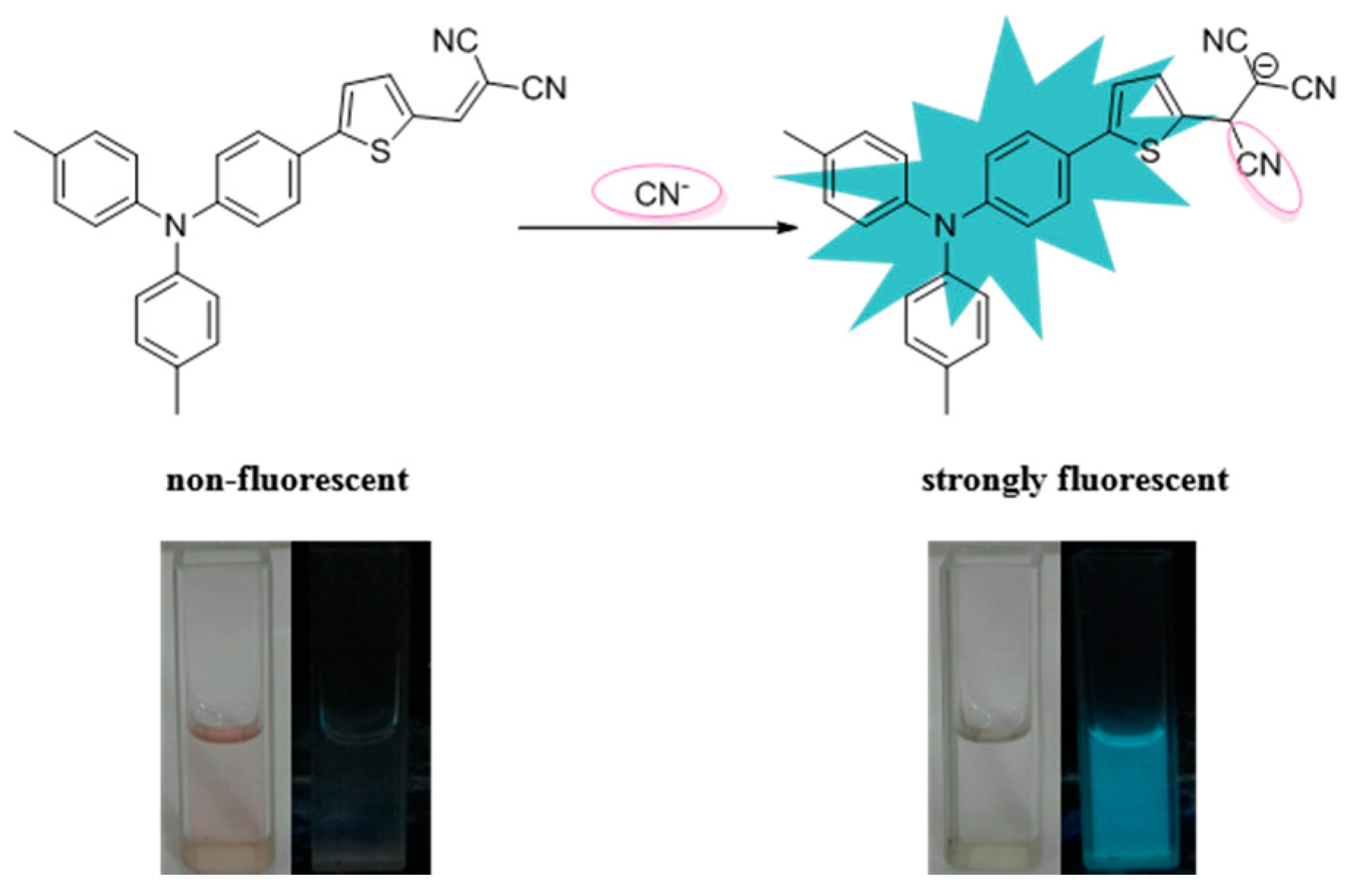



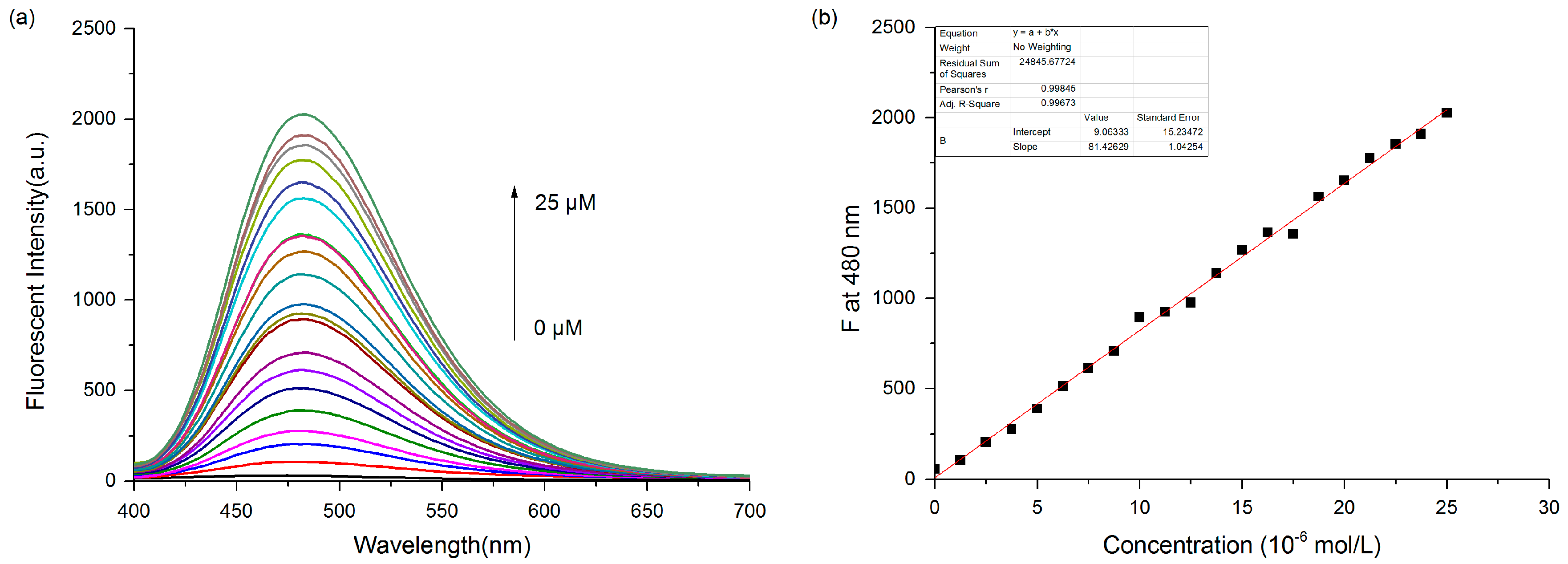

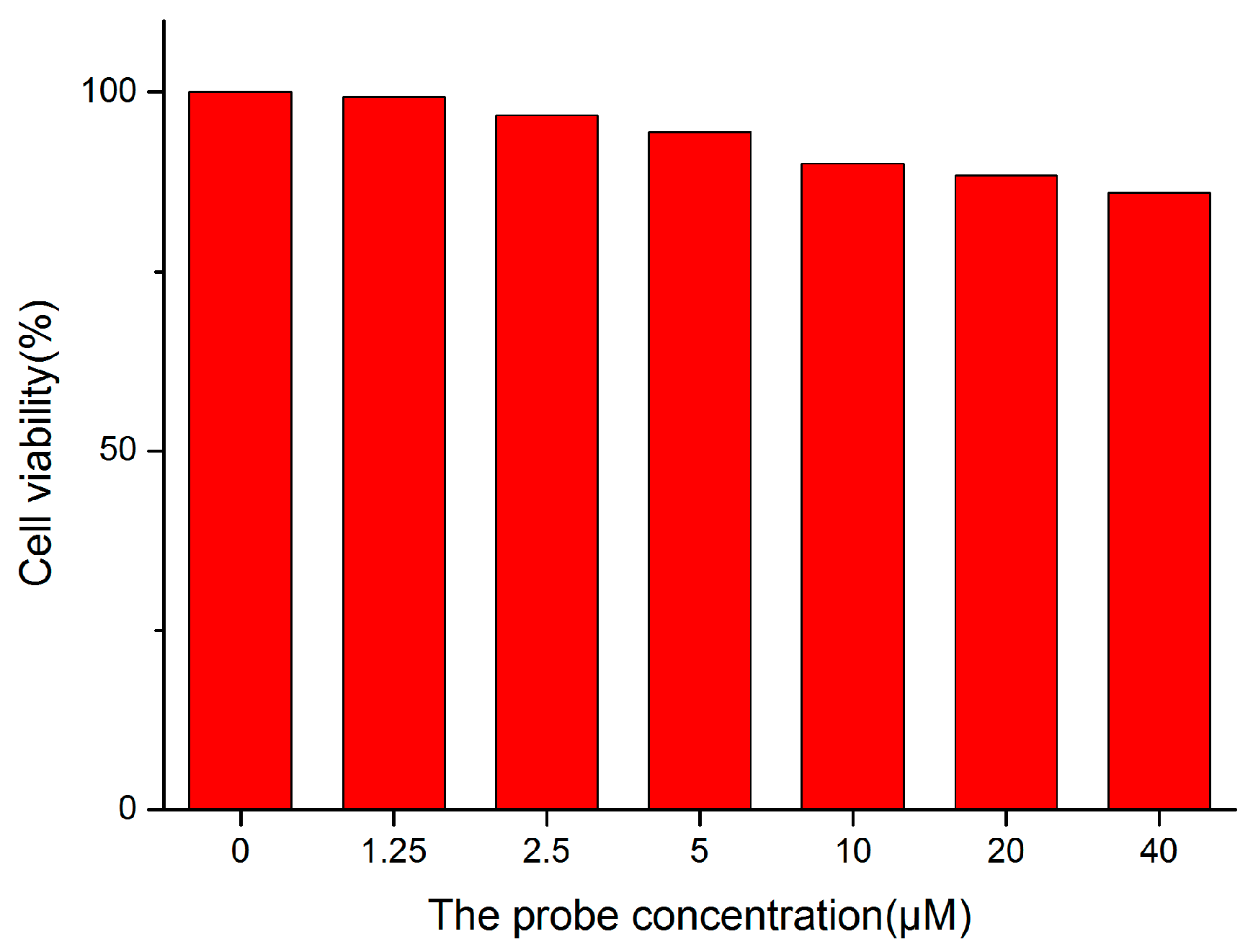
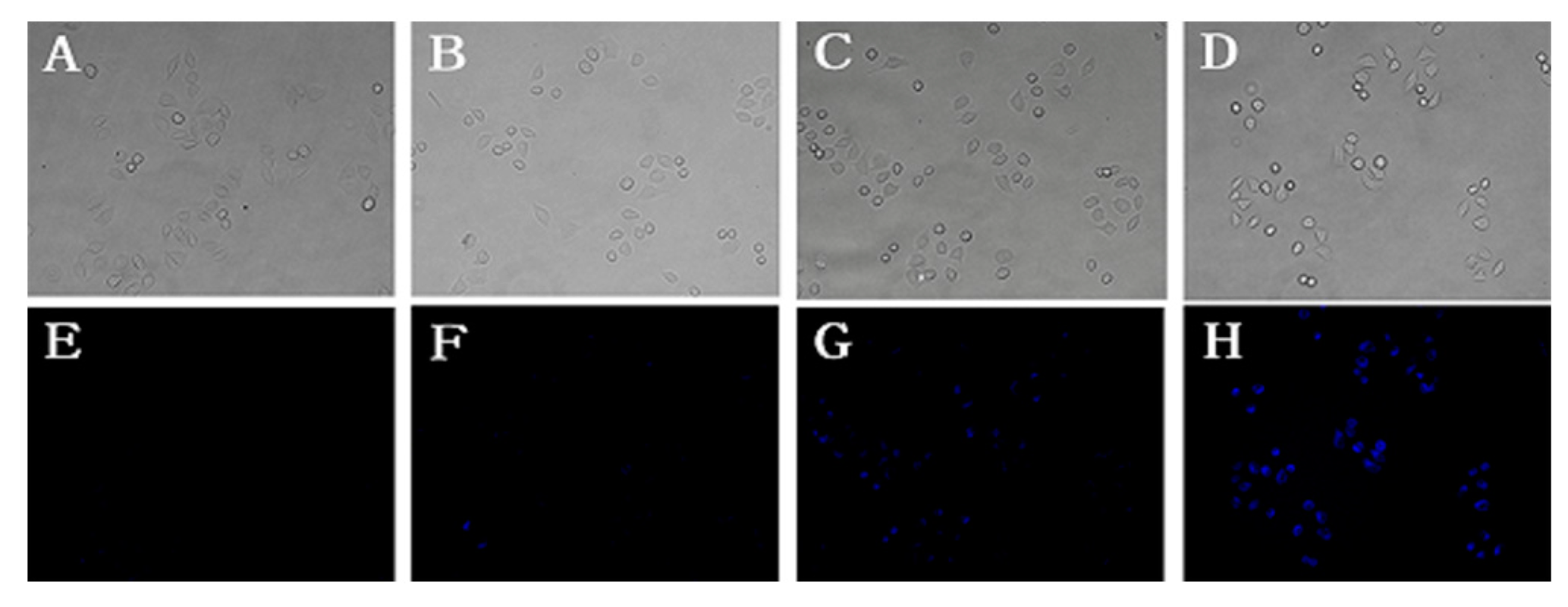

© 2017 by the authors. Licensee MDPI, Basel, Switzerland. This article is an open access article distributed under the terms and conditions of the Creative Commons Attribution (CC BY) license ( http://creativecommons.org/licenses/by/4.0/).
Share and Cite
Zheng, Z.-H.; Li, Z.-K.; Song, L.-J.; Wang, Q.-W.; Huang, Q.-F.; Yang, L. A Biocompatible Colorimetric Triphenylamine- Dicyanovinyl Conjugated Fluorescent Probe for Selective and Sensitive Detection of Cyanide Ion in Aqueous Media and Living Cells. Sensors 2017, 17, 405. https://doi.org/10.3390/s17020405
Zheng Z-H, Li Z-K, Song L-J, Wang Q-W, Huang Q-F, Yang L. A Biocompatible Colorimetric Triphenylamine- Dicyanovinyl Conjugated Fluorescent Probe for Selective and Sensitive Detection of Cyanide Ion in Aqueous Media and Living Cells. Sensors. 2017; 17(2):405. https://doi.org/10.3390/s17020405
Chicago/Turabian StyleZheng, Zi-Hua, Zhi-Ke Li, Lin-Jiang Song, Qi-Wei Wang, Qing-Fei Huang, and Li Yang. 2017. "A Biocompatible Colorimetric Triphenylamine- Dicyanovinyl Conjugated Fluorescent Probe for Selective and Sensitive Detection of Cyanide Ion in Aqueous Media and Living Cells" Sensors 17, no. 2: 405. https://doi.org/10.3390/s17020405
APA StyleZheng, Z.-H., Li, Z.-K., Song, L.-J., Wang, Q.-W., Huang, Q.-F., & Yang, L. (2017). A Biocompatible Colorimetric Triphenylamine- Dicyanovinyl Conjugated Fluorescent Probe for Selective and Sensitive Detection of Cyanide Ion in Aqueous Media and Living Cells. Sensors, 17(2), 405. https://doi.org/10.3390/s17020405




